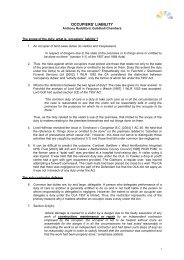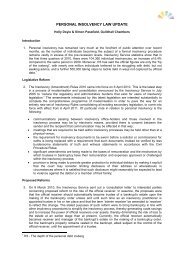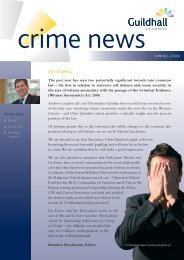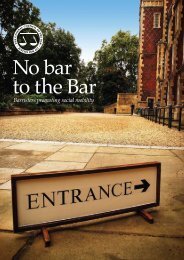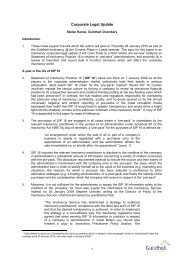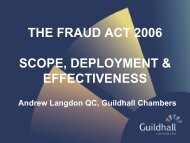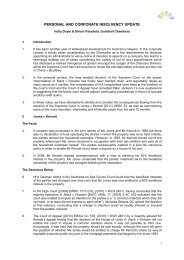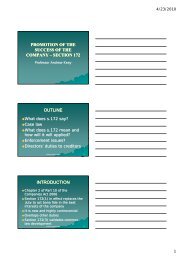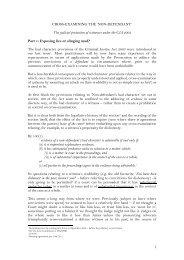Personal and Corporate Update - Holly Doyle & Simon Passfield
Personal and Corporate Update - Holly Doyle & Simon Passfield
Personal and Corporate Update - Holly Doyle & Simon Passfield
You also want an ePaper? Increase the reach of your titles
YUMPU automatically turns print PDFs into web optimized ePapers that Google loves.
the Court at the behest of his trustee? The obvious possibility is to ensure that the question ofhow much of the bankrupt’s pension entitlement falls to be divided among his creditors will bedecided by the Court as part of the balancing exercise required under section 310 IA 1986 ratherthan by the trustee as was the case when it was considered that those rights actually vested inhim from his appointment.70. As a matter of fairness it is suggested that a debtor, whether bankrupt or not, should not beentitled to “hide” assets to which he was immediately entitled in a pension scheme to thedetriment of his creditors. Indeed, as a matter of principle this seems little different from hidingassets by placing them in the name of another or in an off shore bank account or behind a loosebrick in the chimney breast.71. However, the two scenarios differ at least to this degree: in the latter the debtor is deliberatelytaking an asset which would be otherwise available to creditors <strong>and</strong> putting it beyond their reach,whereas in the former the debtor is choosing when <strong>and</strong> how to realise a future asset in the mostbeneficial way for their retirement - the creditor position may have no bearing at all on thisdecision: in this situation the concept of “hiding” assets from creditors is not particularly apt.72. While it might be considered that the distinction between the person who happens to have begunto draw his pension <strong>and</strong> the person who has not is arbitrary, the law is of practical necessity fullof such arbitrary cut off lines e.g. the “relevant time” in preference <strong>and</strong> undervalue claims. It isarguably equally arbitrary that the pension entitlement of a bankrupt who turns pensionable agethe day after his discharge is not treated as income whereas if he just happened to be one yearolder it would be. Further, once the entitlement to elect to receive a payment is treated asincome, there are difficult questions of degree, for instance: many pensions can be cashed in atany point - but would anyone suggest that because a bankrupt is entitled to realise the value ofhis pension at anytime should he wish that the ‘entitlement’ to this ‘cash in value’ should betreated as income?73. There are at least two possible policy reasons to treat a pension entitlement differently from apension which is actually being drawn: the first is autonomy. Being forced to exercise rightsunder a pension in a certain way, which will affect a person significantly for the remainder of theirlife, is a significant invasion to their general autonomy to plan their affairs, whereas if a person isalready in receipt of their pension there is no such issue.74. A second possible policy reason is the desirability of encouraging financial independence in theelderly. A pension is carefully built up over many years of work in order to place a person in thebest possible financial position for his dotage, a time of financial vulnerability. Many people havepension schemes which can be drawn from 55 but either chose to or have work until the age of65+ in order to be in a financial position to retire. Arguably, continuing to work <strong>and</strong> contribute toone’s pension rather than to retire <strong>and</strong> draw one’s pension is responsible behaviour whichsociety should encourage: it means more years of tax contributions <strong>and</strong> less concern that anaging population won’t have the resources to support itself.75. The decision is being appealed.Can an IPO be made in the absence of tangible benefit to creditors?76. In Official Receiver v Negus (Chancery Division, Newey J, 16 December 2011) the OfficialReceiver sought an income payments order against the bankrupt for £40 pcm, being half of thedifference between his income <strong>and</strong> expenses.77. At first instance an order was refused, because the entirety of the sums generated would go todischarge bankruptcy expenses, <strong>and</strong> the creditors would receive nothing.78. Newey J allowed the Official Receiver’s appeal. The fact that the sums would dischargeexpenses only was not a ground to refuse to make the order, as(1) The foundation of the order under s.310 of the Insolvency Act 1986 made no reference toa benefit to creditors,




